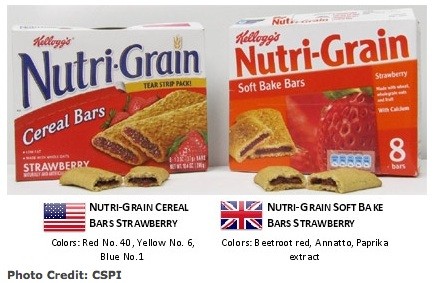You might want to think twice before you give your kid mac and cheese for dinner again or buy her that berry-licious cereal. The FDA was recently considering a warning label for foods with artificial colors. That’s because studies show that artificial colors cause behavioral problems and have been linked to allergies in children and cancer (when tested on lab animals).
The report Food Dyes – A Rainbow of Risks reviews the known risks, as broken down by Fooducate:
Blue 1, Red 40, Yellow 5, and Yellow 6 have long been known to cause allergic reactions in some people. CSPI says that while those reactions are not common, they can be serious and provide reason enough to ban those dyes. Furthermore, numerous studies have demonstrated that dyes cause hyperactivity in children.
Tests on lab animals of Blue 1, Blue 2, Green 3, Red 40, Yellow 5, and Yellow 6 showed signs of causing cancer …
Yellow 5 also caused mutations, an indication of possible carcinogenicity, in six of 11 tests…
In addition, according to the report, FDA tests show that the three most-widely used dyes, Red 40, Yellow 5, and Yellow 6, are tainted with low levels of cancer-causing compounds, including benzidine and 4-aminobiphenyl in Yellow 5.
Europeans have demanded that these dyes be removed from products, yet the artificial coloring ingredients are still served up to the American consumer. For example, look at the difference in these two boxes of bars:
Why the double standard? In Europe manufacturers need to prove an ingredient is safe in order for it to be approved for use. In the U.S.A., it’s innocent until proven guilty. That is, U.S. scientists, researchers or consumers must prove that an ingredient is harmful before it will be banned. Do you really want to keep giving your kids Lucky Charms for 10 years and ‘wait and see’ if any of the ingredients cause cancer?
Katy Farber, Author of Non-Toxic Kids, recommends the following to avoid artificial colors:
*Read labels! Artificial food coloring HAS to be on the label. You’ll see it listed like this: “colored with (RED 40, YELLOW 5, BLUE 1)” as an example.
[n.b. if it says "artificial colors," just move on]
*Avoid regular food coloring in baked goods. Opt for natural versions instead available in the natural food section of your grocery store or your local natural foods store.
*Question brightly colored foods. They likely contain artificial food colorings (otherwise, how could they be so unnaturally bright?). Think rainbow colored popsicles, bright blue frosting, Jell-O, and Fruit Loops.
*Shop at your local natural food co-op, Whole Foods, or Trader Joe’s who refuse to sell any food that contains artificial coloring.
Easy.


I like this blog it’s a master piece! Glad I found this on google.